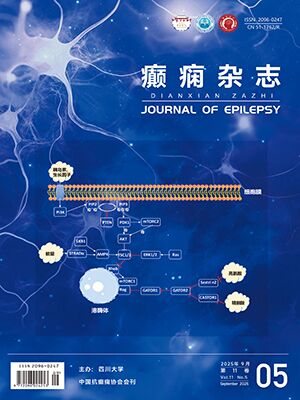| 1. |
Lin Y, Hu S, Hao X, et al. Epilepsy centers in China: current status and ways forward. Epilepsia, 2021, 62(11): 2640-2650.
|
| 2. |
Keezer MR, Sisodiya SM, Sander JW. Comorbidities of epilepsy: current concepts and future perspectives. The Lancet Neurology, 2016, 15(1): 106-115.
|
| 3. |
Tellez-Zenteno JF, Patten SB, Jette N, et al. Psychiatric comorbidity in epilepsy: a population-based analysis. Epilepsia, 2007, 48(12): 2336-2344.
|
| 4. |
Kanner AM. Obstacles in the treatment of common psychiatric comorbidities in patients with epilepsy: What is wrong with this picture? Epilepsy Behav, 2019, 98: 291-292.
|
| 5. |
Yuan H, Silberstein SD. Vagus nerve and vagus nerve stimulation, a comprehensive review: part II. Headache, 2016, 56(2): 259-266.
|
| 6. |
Xu ZYR, Fang JJ, Fan XQ, et al. Effectiveness and safety of transcutaneous auricular vagus nerve stimulation for depression in patients with epilepsy. Epilepsy & Behavior, 2025, 163: 110226.
|
| 7. |
Lampros M, Vlachos N, Zigouris A, et al. Transcutaneous vagus nerve stimulation (t-VNS) and epilepsy: a systematic review of the literature. Seizure, 2021, 91: 40-48.
|
| 8. |
施秀青, 李红艳, 周婕, 等. 中医/中西医结合临床实践指南与专家共识中证据质量评价与推荐意见的应用现状分析. 中医杂志, 2023, 64(6): 581-586.
|
| 9. |
Bauer S, Baier H, Baumgartner C, et al. Transcutaneous vagus nerve stimulation (tVNS) for treatment of drug-resistant epilepsy: a randomized, double-blind clinical trial (cMPsE02). Brain Stimul, 2016, 9(3): 356-363.
|
| 10. |
Rong P, Liu A, Zhang J, et al. Transcutaneous vagus nerve stimulation for refractory epilepsy: a randomized controlled trial. Clin Sci (Lond), 2014, 22: 15684.
|
| 11. |
Yang H, Shi W, Fan J, et al. Transcutaneous auricular vagus nerve stimulation (ta-VNS) for treatment of drug-resistant epilepsy: a randomized, double-blind clinical trial. Neurotherapeutics, 2023, 20(3): 870-880.
|
| 12. |
Aihua L, Lu S, Liping L, et al. A controlled trial of transcutaneous vagus nerve stimulation for the treatment of pharmacoresistant epilepsy. Epilepsy Behav, 2014, 39: 105-110.
|
| 13. |
Hein E, Nowak M, Kiess O, et al. Auricular transcutaneous electrical nerve stimulation in depressed patients: a randomized controlled pilot study. J Neural Transm (Vienna), 2013, 120(5): 821-827.
|
| 14. |
Rong P, Liu J, Wang L, et al. Effect of transcutaneous auricular vagus nerve stimulation on major depressive disorder: a nonrandomized controlled pilot study. J Affect Disord, 2016, 195: 172-179.
|
| 15. |
Tu Y, Fang J, Cao J, et al. A distinct biomarker of continuous transcutaneous vagus nerve stimulation treatment in major depressive disorder. Brain Stimul, 2018, 11(3): 501-508.
|
| 16. |
Trevizol AP, Shiozawa P, Taiar I, et al. Transcutaneous vagus nerve stimulation (taVNS) for major depressive disorder: an open label proof-of-concept trial. Brain Stimul, 2016, 9(3): 453-454.
|
| 17. |
Sateia MJ. International classification of sleep disorders-third edition. Chest, 2014, 146(5): 1387-1394.
|
| 18. |
Miller MA, Howarth NE. Sleep and cardiovascular disease. Emerging Topics in Life Sciences, 2023, 7(5): 457-466.
|
| 19. |
Yang L, Xiao X, Yu L, et al. Neural mechanisms of working memory dysfunction in patients with chronic insomnia disorder. Sleep Medicine, 2023, 112: 151-158.
|
| 20. |
Riemann D, Dressle RJ, Benz F, et al. Chronic insomnia, REM sleep instability and emotional dysregulation: A pathway to anxiety and depression? Journal of Sleep Research, 2024, 34(2): e14252.
|
| 21. |
Zhang S, Zhao Y, Qin Z, et al. Transcutaneous auricular vagus nerve stimulation for chronic insomnia disorder. JAMA Network Open, 2024, 7(12): e2451217.
|
| 22. |
Guo Y, Ding XY, Lu RY, et al. Depression and anxiety are associated with reduced antiepileptic drug adherence in Chinese patients. Epilepsy Behav, 2015, 50: 91-95.
|
| 23. |
Liu A, Rong P, Gong L, et al. Efficacy and safety of treatment with transcutaneous vagus nerve stimulation in 17 patients with refractory epilepsy evaluated by electroencephalogram, seizure frequency, and quality of life. Med Sci Monit, 2018, 24: 8439-8448.
|
| 24. |
Hingray C, McGonigal A, Kotwas I, et al. The relationship between epilepsy and anxiety disorders. Current Psychiatry Reports, 2019, 21(6): 40-53.
|




